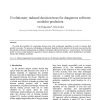VC
2010
13 years 11 months ago
2010
In this research we present a technique for the automatic generation of 3D art form, which allows designers to get access to large number of 3D shapes that can be altered interact...
TNN
2010
2010
Sensitivity versus accuracy in multiclass problems using memetic Pareto evolutionary neural networks
13 years 11 months ago
This paper proposes a multiclassification algorithm using multilayer perceptron neural network models. It tries to boost two conflicting main objectives of multiclassifiers: a high...
SOCO
2010
Springer
14 years 2 months ago
2010
Springer
This paper presents an evolutionary algorithm for modeling the arrival dates in time-stamped data sequences such as newscasts, e-mails, IRC conversations, scientific journal artic...
PPSN
2010
Springer
14 years 2 months ago
2010
Springer
Existing privacy-preserving evolutionary algorithms are limited to specific problems securing only cost function evaluation. This lack of functionality and security prevents thei...
ISCI
2010
14 years 2 months ago
2010
We present a framework for modeling the spread of pathogens throughout a population and generating policies that minimize the impact of those pathogens on the population. This fra...
TFS
2008
14 years 3 months ago
2008
Abstract--This study proposes an efficient self-evolving evolutionary learning algorithm (SEELA) for neurofuzzy inference systems (NFISs). The major feature of the proposed SEELA i...
EC
2008
14 years 3 months ago
2008
We consider an optimization problem of finding the best possible offspring as a result of a recombination operator in an evolutionary algorithm, given two parent solutions. The op...
IPL
2002
14 years 3 months ago
2002
We study the possibility of constructing decision trees with evolutionary algorithms in order to increase their predictive accuracy. We present a self-adapting evolutionary algori...
EC
2002
14 years 4 months ago
2002
Several evolutionary algorithms have been proposed for the satisfiability problem. We review the solution representations suggested in literature and choose the most promising one...
TCS
2008
14 years 4 months ago
2008
In this paper, we study the conditions in which the (1+1)-EA compares favorably to other evolutionary algorithms (EAs) in terms of fitness function distribution at given iteration...



